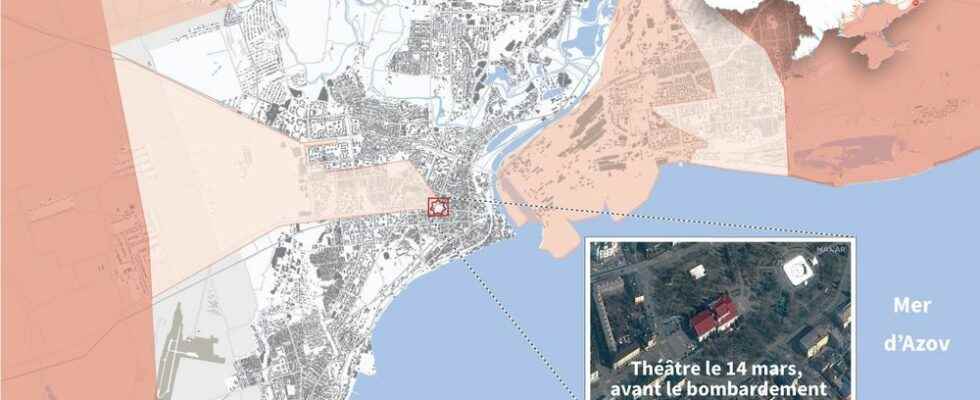The damage is considerable. Buildings blown, gutted and blackened; charred cars; sheet metal, debris and rubble everywhere, thrown for several meters around the buildings. In a video, between the songs of birds, the deaf sound of detonations. On the Telegram group “Marioupol Now”, a photo chases a video, and vice versa, all equally gloomy.
The port city, located in the southeast of the country, in the Donbass, has been besieged and isolated since the beginning of March. Social networks, and the photos posted by the inhabitants themselves, are one of the only – virtual – gateways to documenting the war in Mariupol. The last international journalists, a team from the Associated Press news agency, had to flee the city on March 15, tracked down by Russian forces seeking to maintain total opacity on the situation there.
“You don’t know who’s alive, who’s dead”
Before reaching the west of the country by crossing numerous checkpoints, the reporters were able to show and read about the drama unfolding in Mariupol, on the shores of the Sea of Azov: the bombing of the maternity ward; electricity, water, means of communication and food supplies cut off. Not to mention the incessant firing of machine guns and shells. In mid-March, Pavlo Kirelenko, the governor of the Donetsk region, estimated that “more than 80% of the city’s infrastructure is damaged or destroyed. Of these 80%, around 40% cannot be recovered”. “Mariupol will be part of the list of cities in the world that have been completely destroyed by war, such as Guernica, Stalingrad, Grozny, Aleppo…”, declared, during his return to Athens, the Consul General of Greece to Mariupol.
The testimonies collected from residents who fled the port city attest to “catastrophic” conditions. AT France infoArtiom says that, for lack of access to water, “when it rained, we collected rainwater. When it started to snow, we melted the snow, for the toilet, to wash hands”. At World, Irina Kokurina evokes the lack of communication: “We no longer had any information on the situation or the possibility of speaking to our loved ones. It’s terrible. You don’t know who is alive, who is dead. You don’t know if you whether you can run away or not. You feel completely helpless.” All of them are about finding shelter to protect themselves from the constant bombardment, fear and danger.
Since the start of the war, no humanitarian convoy has been able to reach Mariupol, where everything is lacking. “We don’t have a team on site, nor have we yet managed to get medicines there,” confirms the NGO Doctors Without Borders to L’Express. For the evacuation of civilians, the task is just as difficult. On two occasions, the Ukrainian and Russian authorities have agreed to the establishment of humanitarian corridors to allow those who wish to leave the city. Attempts failed. The former accused the latter of not respecting the ceasefire.
France is co-organizing a “humanitarian operation”
On Friday, a first step forward was taken. Emmanuel Macron announced the organization of a “humanitarian operation” in Mariupol where 100,000 people – out of the 400,000 in the city before the war – would still be blocked. France, Turkey and Greece will be in charge. The president is to meet soon with Vladimir Putin to discuss the terms.
“I hope to be able to involve as many stakeholders as possible in this operation”, continued the Head of State, who wants to lead the evacuation “in the very next few days”. His advisers spoke with Vadim Boychenko, the mayor of Mariupol. Likewise, on Saturday, the French ambassador to Ukraine to talk about possible options on the ground.
At the same time, local authorities have accused Russia of deporting civilians to its territory. On Telegram, Thursday evening, Vadim Boychenko advanced the number of 15,000 inhabitants taken “by force” on board buses, as well as “the confiscation of Ukrainian passports” of inhabitants stuck there. The representative of the United Nations High Commissioner for Human Rights in Ukraine has not (yet) been able to verify these accusations.
Map locating the theater of Mariupol, bombed on March 16 while sheltering hundreds of civilians.
SIMON MALFATTO, ELÉONORE HUGHES, ANIBAL MAIZ CACERES / AFP
Establishing a casualty toll is equally difficult, as the incessant shelling is hampering the work of rescuing and extricating those trapped under the rubble. But according to the latest count communicated by the town hall, at least 2,000 civilians have been killed since the start of the Russian invasion. Including about 300 only in the bombardment of the theater where hundreds of civilians had taken refuge, on March 16 – it is however a first assessment established by the municipality ten days after the facts and impossible to verify. “Many doctors have been killed. This means that all the survivors of the attack will die under the ruins of the theater, or are already dead”, also lamented on Facebookthe day after the attack, Ukrainian MP Serhiy Taruta.
Hired as a volunteer rescuer, the elected municipal official of Mariupol Katerina Soukhomlynova confirmed to AFP that it is “very difficult to count the dead”. She also recalled the still unknown fate of the 400 civilians who were in an art school, bombed on March 20. Such disasters make him say that the toll of civilians killed, given by the town hall, is largely underestimated. The local news site 0629.com.ua, for its part, collected the testimony of a survivor present in the theater during the bombardment, which subsequently managed to flee the city: “What we saw around us was blood and chaos.”
